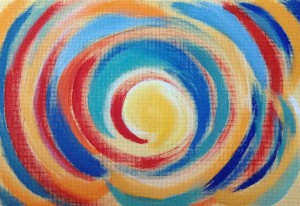One way to define love is "sustained, compassionate attention". These words came from John Muir Laws, a naturalist, educator, and artist who inspires stewardship of the land by sharing his practice of nature sketching. When I read these words, I began to see the importance of my own art practice in developing sustained, compassionate attention for myself.
Read moreGreeting Fear with Love
Fear has been up for me lately. I'm stepping into new unknowns and therefore a new level of courage is required. And in order to function, I've woken up to a new way of greeting fear. Instead of trying to beat it down, or conquer it, which both contain the quality of resistance, I practiced this: "It's OK, fear. Come on in. You are welcome here. Sit down at my table."
Read moreBe Willing to Drop the F Bomb
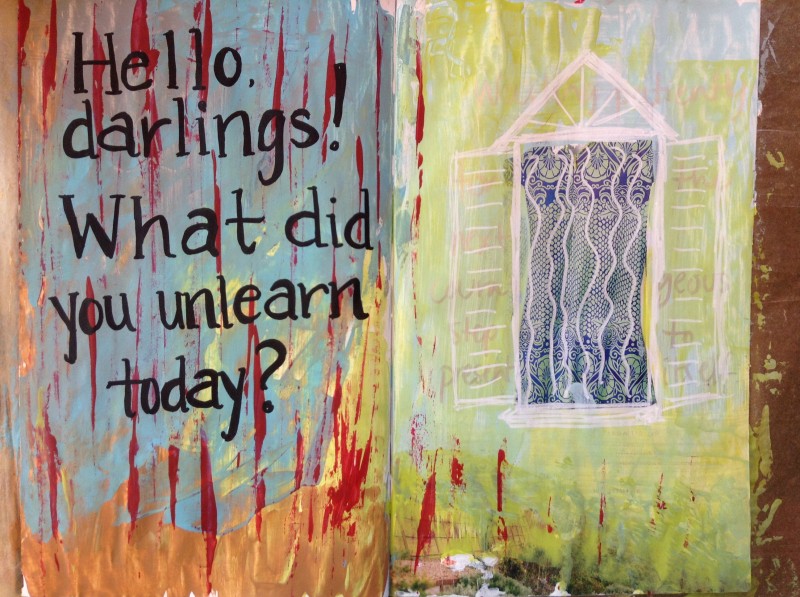 When I was a senior in high school applying to college, I remember one university had as its essay question, "What was your biggest failure and what did you learn from it?". I remember considering not applying to that school because I couldn't think of a failure to write about.
When I was a senior in high school applying to college, I remember one university had as its essay question, "What was your biggest failure and what did you learn from it?". I remember considering not applying to that school because I couldn't think of a failure to write about.
At the time, I was on the receiving end of a lot of attention and praise for never having failed (publicly at least). But now as an adult, I know the trap of living a life based on avoidance of failure. It's no success to have reached all the goals that have been set for you, to have checked all the boxes other people have laid out as important for you, and then to look in the mirror and not recognize yourself. Or to have your body screaming in pain or exhaustion.
Having been there and done that, I have rediscovered the vital importance of failure. Not "achieving" failure as an identity, but being willing to fail. I gave a workshop on Friday to a group of engineers, coaches, consultants, startup founders, and other change agents interested in how groups of people grow and learn. It was based entirely around sound, voice, and music improvisation - in other words, the most common fears of about ninety-nine percent of the population.
The name of the workshop was, "Play the Wrong Note: Daring Adventures in Learning, Failure, and Creativity". The title actually refers to a specific moment in my life when everything changed for me. Those four words - "Play the wrong note" - were the four most compassionate words ever spoken to me by a teacher. No one in a position of authority had ever said, "Lisa, I want to see you break the rules. And I'll help you." It turned out to be the most loving instructions I ever received, and the framework for an entire body of work.
It was about three months in to my sound healing training program. A weekend workshop dedicated to the art of improvisation. I thought I could just observe and let the others do this improvisation thing, which was clearly for "those people" but not me. So I hid behind the teacher with my violin tucked under my arm, hoping he would not see me or ask me to participate in this bluesy, jazzy jam that was happening all around me.
And, of course, at that very moment, he turned around and pointed right at me. "You! Solo!" he said.
I had no idea what to play. I wasn't into blues or jazz and had no reference point for what sounds to make. He could sense that I needed help so he said, "Play the wrong note."
My facial expression must have communicated the feeling I had, which was, "OK. But...which one?". There were an infinite number of wrong notes I could play. How would I know which one was right?
He smiled and took my finger in his hand, and moved it to a random place on the fingerboard of my violin. "Play that," he said gently.
I heard his instructions, but when I tried to play, my bow arm literally would not move. I was so hard-wired to play only the right notes - after daily practicing from age four - that my entire body would not allow me to play any wrong ones.
It was the perfect timing for me. I was ready. I had had a lifetime of good training, practice, and mastery. I was wired for success. But I had no wiring for freedom, fun, or failure. And in that moment, standing there, stranded, in the middle of a room with forty or so people making sounds, having a great time, and waiting for me to solo, I got it.
I could continue to avoid failure, or I could choose to grow into the unknown.
Later that day, in the same workshop, my violin case fell off its chair and onto the floor.
I took it as a sign and stopped avoiding the failures that were wanting to happen for me. I closed my violin school a little over a month later. I started practicing - first in the privacy of my own home, and using my voice, not my violin - making sounds that were all "wrong" to my trained ears. I started PLAYING again. Something I had not done in a long time, and maybe never on my violin.
The adventure that followed was a list of things I could never have planned for my life. I started playing only improvised music, in public, on a stage. I discovered hiking and backpacking. I went to the top of Half Dome and the bottom of the Grand Canyon. I started working at REI - the retail job I was never allowed to have as a teenager because I could earn more money teaching violin or staying home to practice. I won a gig as a gear tester and reporter for Backpacker Magazine, including a free trip to the Outdoor Retailer show in Salt Lake City. I discovered Thai massage and Breema bodywork, which led to traveling to three countries I would never have dreamed of visiting before - Bali, Thailand and Laos. And through my practice of these forms of bodywork, I traded massages for studio days with a couple of artist friends. And I discovered that I could play with paint. Which led to a daily art-making habit. Which has (so far, in the year or so that I've been doing it) led to a juried show, a new blog, and a whole lotta new art supplies in my house.
I could not have written these down on a bucket list because I would never have let my imagination run that wild. Until I was willing to Play The Wrong Note.
And not just once, in a workshop. It was about making a decision to bring the learning from that moment back to my daily life. To find ways to practice that willingness every time the opportunity came up.
It started with music. Being willing to play the wrong note in my personal comfort zone. And then it expanded. Not with planning but as a natural consequence of becoming familiar with the willingness to be "wrong".
So this is my soapbox.
Risk taking is necessary. Being open and willing to fail is necessary. Not knowing is necessary. And these skills are not taught in school. They are not the skills that get you straight A's. They are not the skills that make you look "smart". They are not the skills that earn you the proud distinction of being a Good Daughter (or Wife or Mother). They are not the skills that you use to fill out a college or medical school application. They are often not the stuff of polite cocktail party conversation.
They are the skills of the maverick. The rebel. The free thinker. The one who creates.
So no matter how long ago it was that you experienced your last failure - whether it was just this morning or decades ago or not at all - it is never too late to dive right in. Start practicing the F word.
Take it from a straight A student. Me.
Curious about my "Play The Wrong Note" workshop? Read this blog post or listen to the Creative Conversation we had yesterday about it.
And if you're ready to start practicing Fun, Freedom, and Failure with writing as improvisation, check out my brand new coaching program here.
Wishing You The Fun and Freedom of Being Willing to Fail,
Lisa
Surrender and Loving It 'Til You Know What It Is
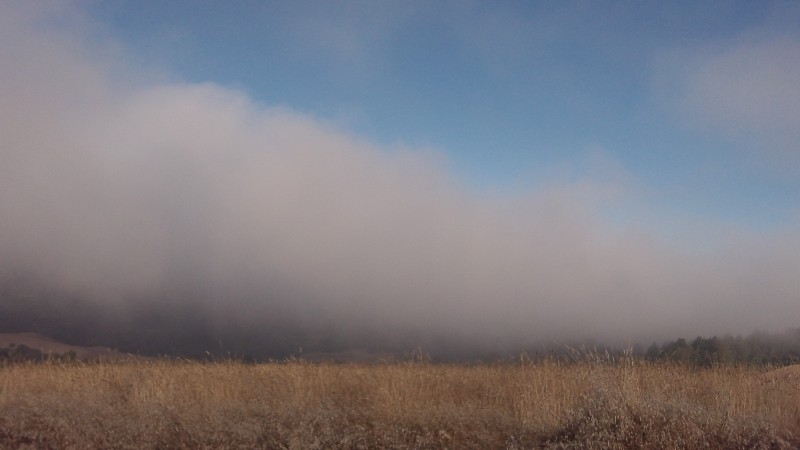 I am in a large group of women artists who have driven up to the ridge of a mountain range and then down a very windy road to a secluded artists retreat program in northern California. All I want to do is stare at the dreamy landscape, watching how the golden green hills go back and back and back, disappearing finally into a fog bank which hovers just above the sea in the distance. I want to watch as the wind blows, the fog clears, and the misty outlines of the hilltops begin to glisten in the midday sunlight. I want to sit and sketch it, and fill in the colors I am seeing, and try to capture the dreaminess, the haziness of it all, the lack of precise outlines which gives it that quality of mystery that makes me want to keep staring.
I am in a large group of women artists who have driven up to the ridge of a mountain range and then down a very windy road to a secluded artists retreat program in northern California. All I want to do is stare at the dreamy landscape, watching how the golden green hills go back and back and back, disappearing finally into a fog bank which hovers just above the sea in the distance. I want to watch as the wind blows, the fog clears, and the misty outlines of the hilltops begin to glisten in the midday sunlight. I want to sit and sketch it, and fill in the colors I am seeing, and try to capture the dreaminess, the haziness of it all, the lack of precise outlines which gives it that quality of mystery that makes me want to keep staring.
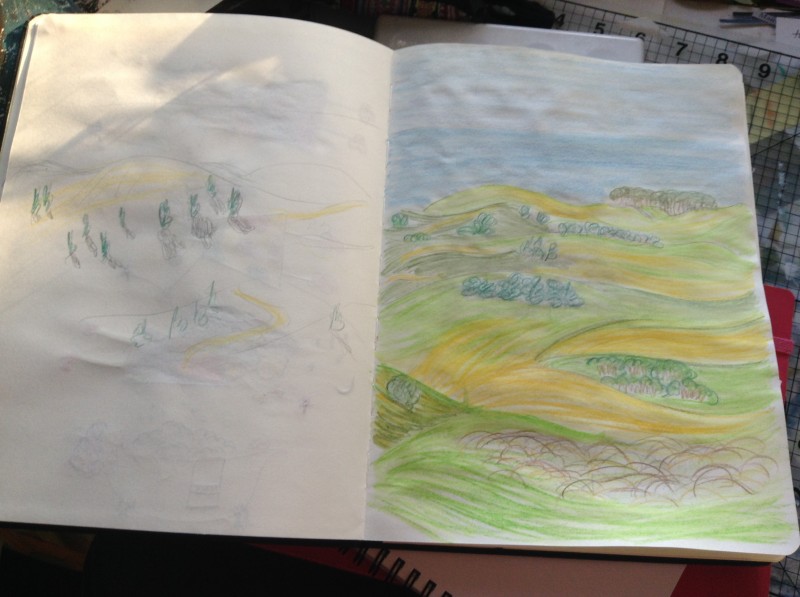
But we have a schedule. There are ranchers and herders moving us along in this schedule, ensuring that we are on time. I help myself to a large lunch - two servings each of lentil soup and kale salad with some fruit on the side. My idea of a perfect meal. But my stomach feels slightly full after all that, and I am ready to rest and digest.
Having forgotten the schedule momentarily, I’m jarred when it is announced that we now need to move into another room for a “movement activity”.
I take my time walking there, hoping those extra few seconds will give my digestive system time to bring the food down a little more.
By the time I join, the circle has been formed and all the women are bouncing lightly on their bare or socked feet. This being one of only 14% of artist residency programs in the country who have a fully spring loaded dance floor, shoes are not allowed.
Ann Swanberg is the leader. I had experienced her work once before in a large church, where she presented her improvisational approach to life in a humorous show. We kept bouncing - this was Ann’s method for keeping us out of our thinking minds and in some other realm governed by the moving, breathing body - and we did a whole host of games designed to get us to drop our personalities by acting silly and free.
What I noticed is that my recent experiences with becoming present were done in the stillness and silent meditative movement of the Breema Center. Somehow in that setting, where I was truly not a personality and there was absolutely no imperative to show up as entertaining in any way, I could feel my own bodily presence. In this setting where everyone was asked to do something silly, there was slight pressure to be “silly enough”. As if stillness would not have been accepted there. But I don’t know because I just flowed with the energy of the room.
One of the more silent and inward-turning exercises of the day did capture my attention. She called it “The Infinity Box” or “Loving It ‘Til You Know What It Is”. The instructions went something like this: Reaching into an imaginary box from which anything is possible, allowing the “Body First” to lead the improvisation, follow the shape your hands spontaneously take as you reach in. As they emerge from the imaginary box, just be with them. Don’t change them or manipulate them into what you think they might be. Just breathe with the shape, feel it.
"Love it ’til you know what it is."
It was fascinating to watch the different shapes my hands took on when I allowed them to. Fingers apart and curved, palms facing up. Fingers together, joined at the thumbs and index fingers. Palms cupped, joined together, facing up. And then waiting. Breathing. Feeling. An answer or image always emerged. But sometimes I had to stay with it longer than expected. The final one I ran out of time on. So I sketched it, and it is permanently imprinted in my bodily memory. I am still wondering what it is.
It reminded me of painting. How the creative practice for me is staying with something long enough to find out what it is. Not to give up. Not to decide in advance that something’s “never going to work”. So often when I have mustered the courage or audacity or love to stay with it, to keep going, to keep loving it, something else so beautiful and magical emerges right on top of it all.
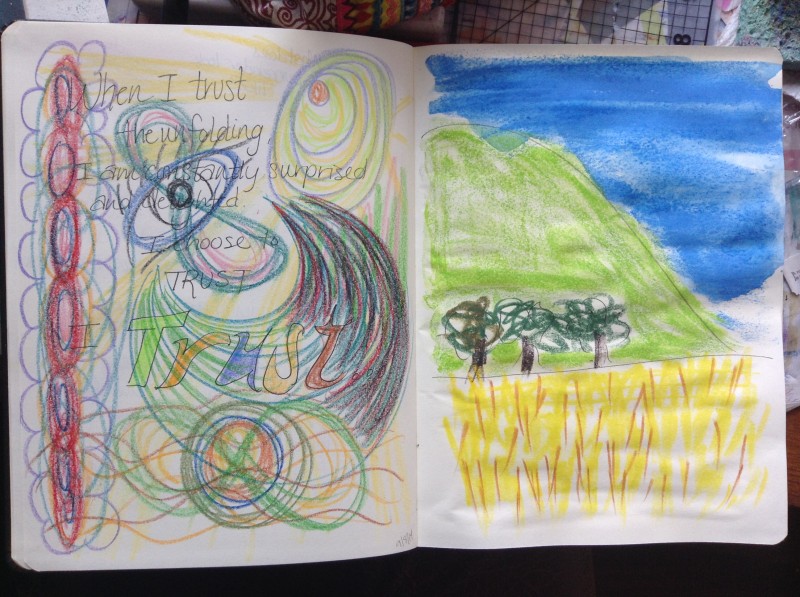
Chris Zydel sent out her newsletter yesterday too, and I happened to read all the way to the bottom. The article was about "Surrender". How surrender is not giving up or weakness or defeat. But rather a form of full presence. That in order to fully participate, there is surrender involved. As I write this, it occurs to me that the four “No…” principles from Breema touch on what kinds of surrender are involved - No Judgment, No Force, No Extra, No Hurry No Pause. Well that’s a lot to give up in order to get to presence! How often are we drowning in judgment, doing more than is needed, rushing around, or not acting because we feel stuck in hesitation.
Surrender is the sweetness of letting life lead. Of loving whatever life gives you until you know what it is. I am attempting to apply it to my body, my relationships, my work decisions, all of which I apply a certain amount of control, changing, and fixing to. I don’t really know the state of full surrender into acceptance. I am pointing towards it sometimes, but I haven’t sunk to the depths of that pool to say, “Huh. So this is it. I’d like to know how this feels. Really.”
Here’s what Chris had to say about surrender:
When a sunflower turns its face to follow the sun, that is surrender. When a seed planted in a rich soil breaks free of its encasement and pushes its way up to the light of day, that is surrender. When a wild mustang gallops wildly and joyfully across a meadow, that is surrender. When a baby tries to grasp a beam of light, laughing delightedly, that is surrender. When you look at a sunset and feel the peace of simply breathing in and out, that is surrender. When you enjoy a delicious meal, letting the flavors tickle your tongue, that is surrender. When you feel drowsy and begin to fall asleep, that is surrender.
In all these experiences you, or the horse or the sunflower are completely giving into what's right there in front of you. You are simply being in the present moment with what you feel drawn to do.
So in other words, surrender is something that happens daily, hourly, minute by minute in our lives. It's so very common and down-to-earth. It's in the most intimate fabric of our existence. And includes everything from the mundane to the ecstatic.
And tomorrow, with the start of the final Energy Gardeners' Club of the year, I am ready to apply the principle of Surrender. Making things happen is not about controlling in order to get what you want. Making is allowing.
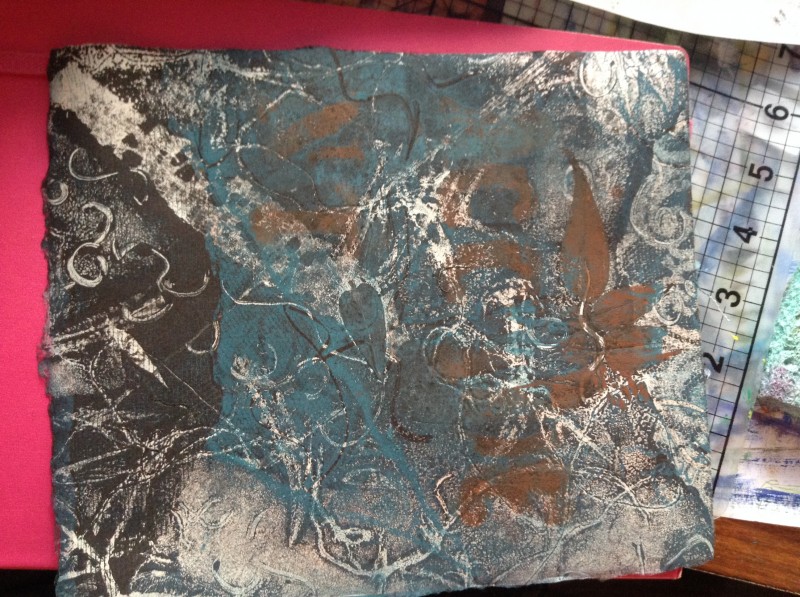
E-Squared Book Club: Week 4
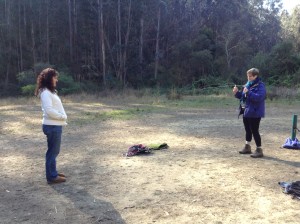 It was a foggy, misty morning, but just before 10 o'clock, the sun began to shine.
It was a foggy, misty morning, but just before 10 o'clock, the sun began to shine.
We gathered to discuss Experiment #5 - the Dear Abby Principle. This states that we each have unlimited access to a constant source of inner guidance from the FP.
Pam talks mostly about the distinction between our conscious mind (logical, rational brain) and inner guidance. Too often we get the two confused, and we use our conscious thoughts as guidance. Oops!
The conscious mind has these important functions:
- identifying problems
- formulating goals
- making judgments
- comparing current experience to past experience
- interpreting results and building models
However, it's not the source of guidance when you "don't know" what to do, or when you want to take a step toward a vision you want to create.
I'm curious: what forms has YOUR inner guidance come in?
For me, it's been learning to listen to my own body. My "temple of truth", as I call it. I used to use my mind to drive my body like it was my workhorse. Now I am more tender, more astute at listening, and take the time to honor what my body is communicating at all times. I am learning.
Others in the group described their inner guidance as "intuition", "gut reaction", "knowingness", a feeling, a sound or word, an image that appears.
No matter what your inner guidance looks, sounds, or feels like, it's about your relationship with it. Getting to know it so you can begin to trust it.
Shirley shared the results of Experiment #3. She asked for a piano to appear in her life. It was offered immediately and sincerely. She observed for over a week before she became clear that all she had to do was ACCEPT the offer. To SHOW UP and take the steps of receiving. WOW. That was a big one! It's always available, and sometimes it's right in front of us, but we have to be willing to walk toward it. Thank you, Shirley!
Tammy got a crystal clear answer to her question, "Should I get a new door, or repair the old one?". Now it's a matter of walking toward that answer.
We also tried the magic wands again (yes, we LOVE them! We'll even try them with strangers who wander into the clearing and wonder what we're doing there.). Tammy brought another question to the wands, one where the answer she had received was not quite lining up with the feelings she was getting in her body. The wands gave her crystal clarity.
Finally, we were gifted with the raw materials for our next Experiment #6! We each received a packet of sunflower seeds and some soil from Tammy's garden. I planted my seeds last night, and it's just amazing how much faster one row is already growing compared to the other! :)
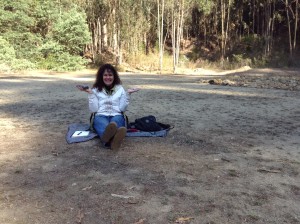
I wanted to share the recording of the evening phone meeting. It is one hour and fifteen minutes, unedited. There is some great discussion and sharing from Danielle as we talk about letting go of the "how", how to get clear on an intention, and practicing. Here is the link. Enjoy!
Next week, we talk about the next TWO chapters - Experiments #6 (the great seed race) and #7 (what happens when you infuse your food with love?).
You can join the E-Squared Book Club anytime until November 20th. And if you've been reading the book, please share your stories in the comments!
How To Practice True Self-Confidence
Here’s my definition of true self-confidence. I’m so over the days of being in a classroom and each of us painting our own “version” of what the teacher wants us to paint. We are told that this kind of imitation – producing something that looks “as good as” what we are told is a “masterpiece” – is what we should be striving for. That we should practice for mastery as it is defined by the experts.
I disagree.
I’m interested in the kind of self-confidence that comes from facing the blank page, the open space, the silence, the void. Where there is no map. Only your body, your breath, your instincts, and your wild-eyed awareness. Only by choosing to “go there” – to show up in territory that is uncharted for you – can you experience what I’m talking about here.
For me, it requires venturing outside my zones of mastery and wondering what it’s like to be a novice. I never sang, so I explored what my voice could do with sound. I never painted, so I played with brushes and paper and colors. I bring back the lessons of these experiences to the areas of my life where I may be stagnating in my attachment to being “good at it”.
When was the last time you stood at the edge of your comfort zone, and faced the open space?
When was the last time you took a step into that open space, truly not knowing where it would lead?
Each time you give yourself this kind of opportunity, you discover your relationship with fear, and you have the chance to see and accept yourself as you are.
I used to be good at making money. I learned all my business skills from venture capitalists, the masters of making as much as possible from as little as possible. Money, that is. But even with a pile of money coming in, and plenty in the bank, I was distant and disconnected from its source. I felt no direct relationship with my presence and the money coming in.
Now I’m exploring a new relationship with money. One that is not so distant or quick. One that asks me to pause, reflect, and give or receive from a place of whole SoulBodyMind participation. With this full participation, I am discovering a new way to define value that is not about what we’re told, but about what feels right, and what sustains and supports life. It goes beyond the transaction, but it begins before the transaction. It infuses money with intention, value, and energy that aligns with the exchange occurring between individuals.
I’m taking a hula dancing class – another novice territory for me. I get to notice that the military precision and emphasis on “getting it right” no longer motivate me. I observe, and patiently wait for the music to start so my eyes can close and I can start to listen inwardly to the grace and fluidity within me. I am not there to perform or perfect any outer forms. I am there to touch the soft and lilting place within me. I can enjoy myself whether I am “doing it right” or not.
True self-confidence. We are told it comes from practice, practice, practice. But it really does matter what you are practicing and how you are as you are practicing. Knowing the what and how you are require awareness and attention.
Do you gain true self-confidence by following instructions and repeating them over and over again, making sure you’re doing it right by matching the people around you or getting the teacher’s approval?
Or are you simply gaining more practice in following, trusting others before yourself, and living in avoidance of the dreaded feeling of “doing it wrong” or “sticking out” from the others?
Believing that this builds confidence is a bit like a caterpillar believing it could acquire the grace and confidence of a butterfly if only it put on a pair of colorful wings and took flying lessons.
But the real way that a caterpillar acquires butterfly qualities – which are part of the caterpillar's natural potential – is to make the courageous decision to begin weaving a cocoon. Once it completes this weaving, the caterpillar has created a container for itself where the world it once knew completely dissolves. The processes that occur inside the cocoon are natural, and they unfold according to the laws of the caterpillar’s own nature, which is to transform completely into the form of a butterfly, with the potential to fly and spread beauty.
What I mean by true self-confidence is a sense of trust in the desires of your true nature and your ability to find expression for them in your life. To show up and create experiences for yourself and others that reflect the uniqueness of what only you can offer.
If you feel like you’re standing over here and true self-confidence is somewhere “over there”, maybe you just need to know what to start practicing.
1. Listen. What is your heart’s truth? What is your true nature wanting you to hear? Listen for it. You may have to get very still and very quiet in order to hear its sound. Do it. It is worth it.
2. Decide. What decision do you have to make in order to create the space – weave the cocoon – for the expression of your true nature to take form? You may have to say goodbye to one way of life, and hold only in your imagination the possibility of another. But the decision to create space is necessary to start the process in motion.
3. Explore. Begin practicing the experience of being in expression of your true nature. Explore visual art, movement, sound, voice, and music, contemplative practices, writing, and other adventures that allow you to let go of your thinking mind’s conditioning. Connect with imagination, play, elements of the natural world, and wordless forms of expression.
4. Observe. Along the way, you will encounter all the fears and doubts and obstacles that have ever stood in the way of your true self-confidence. Know that this is all happening as a gift for you. Resist none of it. Indulge in none of it. Observe with precision and gently come back to your heart’s truth, your vision, the feeling of expressing your true nature in the world you are actively creating.
5. Repeat. With each expression of your vision that you experience fully, you will give rise to more visions. More decisions to create space. More opportunities to observe and come back. With more practice, the repetition becomes more familiar, more of a way of approaching your life in any given situation.
With this kind of practice – Listen, Decide, Explore, Observe, Repeat – your muscles of true self-confidence will be getting worked consistently and repetitively, with specific feedback you observe in your own experience.
Steps 1, 2, and 5 are up to you. Once you can envision these steps, it may be easier to accept yourself where you are, and begin moving through it. A coach can help to illuminate the process and help you see where you are right now. You can begin step 3 with your own sense of adventure, exploration, and imagination. Sometimes it helps to have the inspiration of other people’s stories, or a group in which to explore with companionship and support.
Step 4 is where a coach like me can be very helpful. The fears and doubts are often lifelong, deeply held habits of thinking that have not been questioned in many years. They may be the foundation of your identity, and without a gentle but firm and nonjudgmental atmosphere, the ego will put up a fight to its own death to preserve these beliefs.
Once you are familiar with your own responses to fear and doubt, and learn some simple methods to work with yourself in releasing these beliefs, you become your own best coach. You are limited only by your willingness to imagine more, and your curiosity to know the depth and expansiveness of what you can create from your own true self-confidence.
Trying To Squeeze Blood From A Turnip and The Power of No Force
Part of a series exploring each of the Breema Nine Principles of Harmony
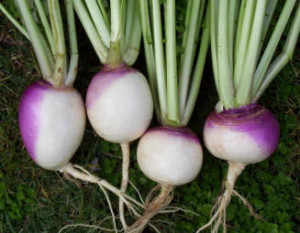
Trying to squeeze blood from a turnip is a lot like being at war with reality.
What are the ways we use force against what is, in an attempt to make things the way we think (and thought is the key word here) they should be?
Does it ever really work? And at what price? When we use force, do we even know that our sanity, our inner peace, our body, exists? Or do we only see the blood we want so desperately to come from the turnip, or whatever we are applying force to?
If we see clearly, we first begin to recognize that we are not getting the blood we want, despite all the effort. If we continue to look, we might be able to recognize that there's a turnip involved, a turnip that is quite innocent, being a turnip. It has no blood to give. It's just being squeezed, and squeezed some more, harder and harder. You (the one who is squeezing) keep getting more frustrated, but the turnip is not doing anything different. Surprise, surprise, it's still a turnip! Your squeezing, your effort, your frustration, your attempts, have done absolutely nothing to change that.
The turnip seems puzzled. It seems to ask, "Why are you angry at me for being a turnip? Why are you frustrated that there's no blood in me to give? You are getting everything you possibly can from me, because I am a turnip!"
If we look really deeply, we might then see that it's not the turnip who has the problem. We are, at some level, insane for being attached to an outcome that does not - cannot - exist. Until we see all of this clearly there is no way we will let go of our grip on the turnip. We will keep squeezing and squeezing, until our hand gives out or our frustration gets the better of us. The turnip won't yield any blood, and it probably won't even change shape. But what will we be left with? A sore hand, and a broken spirit. Time spent in useless frustration, curses thrown at the luck we were dealt. And no blood.
Not a very fulfilling way to pass the time. Or a very good way to use the strength in your hands.
Working with the body, I've noticed that there is power in the hand when it receives. When you align your entire body, placing your hand in a position where, when it simply receives the weight of your body, it carries the entire universe in its palm. There is no effort in that moment. There is intention and presence in positioning your body to be able to receive. But once those intentions and alignments are in place, the rest is effortless. There is No Force.
However, there is tremendous power. In the moment of No Force, there is space for the power to heal, to release, to discover, to transform. When we let go of force, we merge with reality. Reality is kind, if we allow it to show us what we need to see.
No Force is a way to practice kindness toward yourself. The beneficiaries of No Force will extend beyond you, but if you need a reason to begin, begin with what is kind to yourself.


